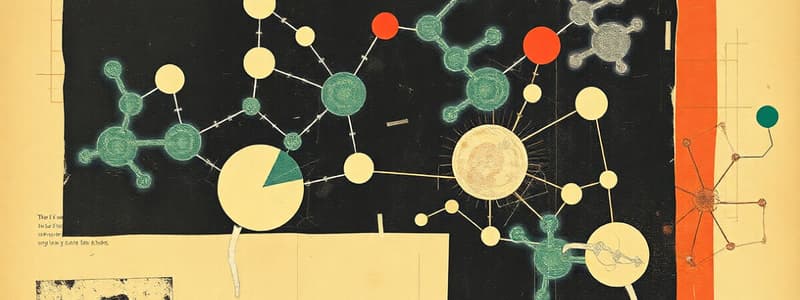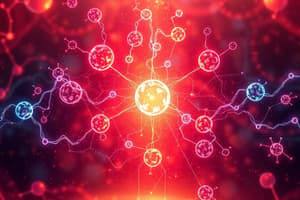Podcast
Questions and Answers
What effect does the size and charge of R groups have on the bonds within the backbone?
What effect does the size and charge of R groups have on the bonds within the backbone?
- They increase the likelihood of double bond formation.
- They enable free rotation around all bonds.
- They have no effect on the bonds.
- They can hinder rotational movement. (correct)
Which angles increase as the carbonyl or amide nitrogens rotate clockwise?
Which angles increase as the carbonyl or amide nitrogens rotate clockwise?
- Φ and Ψ angles increase. (correct)
- Φ and Ψ angles decrease.
- Φ and Ψ angles alternate randomly.
- Φ and Ψ angles remain constant.
In a protein structure, what role do aromatic amino acids play?
In a protein structure, what role do aromatic amino acids play?
- They serve as the primary energy source for proteins.
- They can be stacked to generate stabilizing forces. (correct)
- They enhance the flexibility of the protein backbone.
- They create hydrogen bonds exclusively.
What configuration of Φ and Ψ angles is indicated in the conformation shown?
What configuration of Φ and Ψ angles is indicated in the conformation shown?
How does the charge state of a protonated/deprotonated amino acid affect its behavior?
How does the charge state of a protonated/deprotonated amino acid affect its behavior?
What phenomenon occurs when aromatic amino acids are stacked?
What phenomenon occurs when aromatic amino acids are stacked?
What is the consequence of rotational hindrance in peptide bonds?
What is the consequence of rotational hindrance in peptide bonds?
What primarily affects the stability of protein architecture?
What primarily affects the stability of protein architecture?
What is the effect of covalent modification on enzyme activity?
What is the effect of covalent modification on enzyme activity?
Which of the following is NOT a common modification in covalent regulation of enzymes?
Which of the following is NOT a common modification in covalent regulation of enzymes?
What is the primary function of ATP in the cell?
What is the primary function of ATP in the cell?
Which of the following describes allosteric regulation?
Which of the following describes allosteric regulation?
Which role do NADH and NADPH play in metabolic processes?
Which role do NADH and NADPH play in metabolic processes?
How do competing metabolic pathways minimize interference with each other?
How do competing metabolic pathways minimize interference with each other?
What type of enzyme regulation involves hormonal signals?
What type of enzyme regulation involves hormonal signals?
What is released during the hydrolysis of ATP?
What is released during the hydrolysis of ATP?
Which method is NOT a form of regulating enzyme activity?
Which method is NOT a form of regulating enzyme activity?
Which of the following statements about NAD+ is true?
Which of the following statements about NAD+ is true?
What is the relationship between ATP and ADP?
What is the relationship between ATP and ADP?
What do catabolism and anabolism require for their regulation?
What do catabolism and anabolism require for their regulation?
Where does the energy for cellular activities primarily come from?
Where does the energy for cellular activities primarily come from?
What is the significance of penicillin’s structure in its function as an antibiotic?
What is the significance of penicillin’s structure in its function as an antibiotic?
Which type of coenzyme directly activates a substrate by forming a covalent bond?
Which type of coenzyme directly activates a substrate by forming a covalent bond?
In what way does the presence of an enzyme dramatically affect a reaction rate?
In what way does the presence of an enzyme dramatically affect a reaction rate?
What cellular function do coenzymes primarily assist with?
What cellular function do coenzymes primarily assist with?
What occurs when penicillin binds to glycopeptidyl transferase?
What occurs when penicillin binds to glycopeptidyl transferase?
What characteristic differentiates activation-transfer coenzymes from oxidation-reduction coenzymes?
What characteristic differentiates activation-transfer coenzymes from oxidation-reduction coenzymes?
What role do coenzymes usually have in the human body?
What role do coenzymes usually have in the human body?
How does the reaction rate in the absence of enzyme compare to the rate with enzyme present?
How does the reaction rate in the absence of enzyme compare to the rate with enzyme present?
Which of the following groups is associated with hydroxyl?
Which of the following groups is associated with hydroxyl?
What type of compounds are nucleophiles?
What type of compounds are nucleophiles?
Which of the following is NOT an example of an electrophile?
Which of the following is NOT an example of an electrophile?
Which amino acid substitution is likely to lead to a permanent alteration in enzyme activity due to phosphorylation?
Which amino acid substitution is likely to lead to a permanent alteration in enzyme activity due to phosphorylation?
What is the primary impact of reversible covalent modifications on enzymes?
What is the primary impact of reversible covalent modifications on enzymes?
Which functional group is primarily modified in enzyme phosphorylation?
Which functional group is primarily modified in enzyme phosphorylation?
Which of the following best describes cationic imine in terms of electrophilicity?
Which of the following best describes cationic imine in terms of electrophilicity?
Which substitution at a serine side chain is least likely to affect enzyme activity?
Which substitution at a serine side chain is least likely to affect enzyme activity?
At which pH does half of the molecules of an amino acid with a charged side chain exist in a charged state?
At which pH does half of the molecules of an amino acid with a charged side chain exist in a charged state?
What happens to the charge on the side chain of histidine when the pH increases?
What happens to the charge on the side chain of histidine when the pH increases?
Which of the following solutions is considered neutral?
Which of the following solutions is considered neutral?
Which of the following pH values indicates the most acidic solution?
Which of the following pH values indicates the most acidic solution?
What charge does a carboxylic acid group have at physiological pH?
What charge does a carboxylic acid group have at physiological pH?
At which pH range do human blood and tears generally fall?
At which pH range do human blood and tears generally fall?
What occurs to the pH level when there is an increase in $[H^+]$ concentration?
What occurs to the pH level when there is an increase in $[H^+]$ concentration?
Which of the following represents a basic solution on the pH scale?
Which of the following represents a basic solution on the pH scale?
In terms of amino acid charge, what is the significance of the pKa value?
In terms of amino acid charge, what is the significance of the pKa value?
What is the expected charge of a hydroxyl ion ($OH^-$) at high pH?
What is the expected charge of a hydroxyl ion ($OH^-$) at high pH?
Which of the following is a characteristic of weak acids in relation to pH and pKa?
Which of the following is a characteristic of weak acids in relation to pH and pKa?
Which of the following statements is true regarding amino acids at physiological pH?
Which of the following statements is true regarding amino acids at physiological pH?
Which of the following would likely lead to a decrease in $[OH^-]$ concentration?
Which of the following would likely lead to a decrease in $[OH^-]$ concentration?
Which of the following substances would have a higher concentration of $H^+$ than $OH^-$?
Which of the following substances would have a higher concentration of $H^+$ than $OH^-$?
Flashcards
Rotationally hindered bonds
Rotationally hindered bonds
Single bonds in the peptide backbone can have limited rotation due to steric hindrance
Φ and Ψ angles
Φ and Ψ angles
Angles specifying the rotation around the peptide backbone connecting backbone atoms.
Conformation at 180°
Conformation at 180°
Φ and Ψ angles positioned at 180 degrees (or -180 degrees) exhibit a specific backbone conformation.
Aromatic amino acids
Aromatic amino acids
Signup and view all the flashcards
Peptide/Protein Structure
Peptide/Protein Structure
Signup and view all the flashcards
Protonation/Deprotonation
Protonation/Deprotonation
Signup and view all the flashcards
Amino acid interactions
Amino acid interactions
Signup and view all the flashcards
Protein conformation
Protein conformation
Signup and view all the flashcards
Allosteric Regulation
Allosteric Regulation
Signup and view all the flashcards
Covalent Modification
Covalent Modification
Signup and view all the flashcards
Proteolytic Cleavage
Proteolytic Cleavage
Signup and view all the flashcards
Isoenzymes
Isoenzymes
Signup and view all the flashcards
Regulation by Availability
Regulation by Availability
Signup and view all the flashcards
Amino Acid Charge
Amino Acid Charge
Signup and view all the flashcards
pKa
pKa
Signup and view all the flashcards
Titration Curve
Titration Curve
Signup and view all the flashcards
Physiologic pH
Physiologic pH
Signup and view all the flashcards
α-carboxylic acid group
α-carboxylic acid group
Signup and view all the flashcards
α-amino group
α-amino group
Signup and view all the flashcards
Side Chain
Side Chain
Signup and view all the flashcards
Acidic Solution
Acidic Solution
Signup and view all the flashcards
Basic Solution
Basic Solution
Signup and view all the flashcards
Neutral Solution
Neutral Solution
Signup and view all the flashcards
pH Scale
pH Scale
Signup and view all the flashcards
Transition-state analog
Transition-state analog
Signup and view all the flashcards
Histidine
Histidine
Signup and view all the flashcards
Penicillin
Penicillin
Signup and view all the flashcards
Glycopeptidyl transferase
Glycopeptidyl transferase
Signup and view all the flashcards
Battery Acid
Battery Acid
Signup and view all the flashcards
Gastric Juice
Gastric Juice
Signup and view all the flashcards
Human Blood
Human Blood
Signup and view all the flashcards
Activation-transfer coenzymes
Activation-transfer coenzymes
Signup and view all the flashcards
Oxidation-reduction coenzymes
Oxidation-reduction coenzymes
Signup and view all the flashcards
Thiamine pyrophosphate (TPP)
Thiamine pyrophosphate (TPP)
Signup and view all the flashcards
Hydroxyl Group
Hydroxyl Group
Signup and view all the flashcards
Sulfhydryl Group
Sulfhydryl Group
Signup and view all the flashcards
Imidazole Group
Imidazole Group
Signup and view all the flashcards
Nucleophiles
Nucleophiles
Signup and view all the flashcards
Electrophiles
Electrophiles
Signup and view all the flashcards
Phosphorylation
Phosphorylation
Signup and view all the flashcards
Enzyme Activity Alteration
Enzyme Activity Alteration
Signup and view all the flashcards
Metabolic Pathways
Metabolic Pathways
Signup and view all the flashcards
Catabolism
Catabolism
Signup and view all the flashcards
Anabolism
Anabolism
Signup and view all the flashcards
NADH and NADPH
NADH and NADPH
Signup and view all the flashcards
Compartmentalization
Compartmentalization
Signup and view all the flashcards
Cellular Energy Cycle
Cellular Energy Cycle
Signup and view all the flashcards
Regulation of Metabolism
Regulation of Metabolism
Signup and view all the flashcards
Study Notes
Metabolism: An Overview
- Metabolism encompasses all life-sustaining chemical reactions in organisms
- Its main purposes are converting food to energy, converting food to building blocks for molecules like proteins, lipids, and nucleic acids, and eliminating metabolic wastes
- It involves hundreds of enzymatic reactions organized into discrete pathways
- These pathways involve many specific chemical intermediates transforming substrates to end products
- Catabolism is oxidative and exergonic, breaking down complex molecules to release energy
- Anabolism is reductive and endergonic, building complex molecules requiring energy
Structure of BS2003 - Biochemistry II
- Students are provided with a booklet, "Essentials and Beauty of Biochemistry," as foundational material
- Pre-recorded lectures are made available electronically, allowing for flexible learning
- Weekly tutorial sessions and online coffee sessions are provided for clarification
- The first online coffee session, on August 13th at 8:30 AM, is scheduled to address questions and reinforce learning outcomes
- Practical course content related to carbohydrate catabolism, and lipids and fatty acids is covered in weeks 8 and 9, respectively
BS2003 - Biochemistry II - Learning Outcomes
- Identifying classes of organic molecules in food
- Describing metabolic processes of proteins, carbohydrates, and nucleic acids, and fatty acids,
- Classifying key catalysts involved in metabolic processes
- Determining relationships between pathways related to the digestion and synthesis of amino acids, fatty acids, and nucleic acids, as well as carbohydrates
Recommended Textbooks
- Voet & Voet: Biochemistry, 3rd edition, John Wiley & Sons
- Mathews, van Holde, Ahern: Biochemistry, 4th edition
- Berg, Tymoczko & Stryer: Biochemistry, 5th edition, Spectrum
- Horton, Moran, Scrimgeour, Perry & Rawn: Principles of Biochemistry, 4th edition
- Essentials and Beauty of Biochemistry
Metabolic Fuels and Dietary Components
- The body requires synthesizing the components it cannot acquire from the diet and protecting itself from toxins from the environment
- It metabolizes dietary components through pathways such as fuel oxidation, fuel storage and mobilization, biosynthesis, and detoxification.
- Our diet provides energy in the form of calories from elements like carbohydrate, fatty acids, and proteins.
Carbohydrates: Monosaccharides
- Monosaccharides typically exist in ring structures, with a carbonyl group reacting with a hydroxyl group within the same molecule
- Rings formed are five or six-membered
- The anomeric carbon is a result of intramolecular bonding from the carbonyl group and the hydroxyl group
- These molecules also undergo mutarotation, a process where the a and ß positions spontaneously interconvert when the ring opens and closes
Carbohydrates
- A disaccharide contains two monosaccharides linked by an O-glycosidic bond
- Oligosaccharides contain 3 to roughly 12 monosaccharides
- Polysaccharides have tens or thousands of monosaccharides
- Starch and glycogen are examples of branched polymers of glucosyl residues
- Polysaccharides can be found as components in the cell walls, and in animals, as energy storage molecules.
The Three Key Polysaccharides Made From Glucose Monosaccharides
- Cellulose, starch, and glycogen differing in linkage and branching
- Cellulose — used for structural support
- Starch — energy storage in plants
- Glycogen — energy storage in animals
Energy Content of Food Constituents
- Energy content of fat, glycogen, protein, glucose is discussed in kJ/g and total amounts in a human
- Important advantages of storing energy in fatty acids compared to sugars or amino acids relate to fatty acid structure and their suitability form storage tissue
Saturated and Unsaturated Fatty Acids
- Fatty acids can be saturated or unsaturated, based on the presence or absence of double bonds in the carbon backbone
- Melting point varies based on the degree of saturation—saturated are typically solid at room temperature, while unsaturated are typically liquid
- Trans fats differ from naturally occurring fatty acids, and are often used in food substitutes
Amino Acids and Peptide Formation
- Twenty amino acids are building blocks of proteins
- Amino acids differ in their side chains, which contain various atoms, and groups
- Amino acids are categorized based on their properties
The Acidic and Basic Amino Acids
- The pKa values differentiate acidic and basic amino acids
- It correlates with their ability to gain or lose a proton
- The isoelectric point (pI) identifies the pH at which the net charge of an amino acid is zero
Dissociation of Side Chains of Amino Acids
- Describes how the amino acid side chains can gain or lose protons depending on the pH of the environment
- pKa values indicate at what pH half the molecules in the solute will become ionized
Enzymes as Catalysts
- Enzymes are proteins that catalyze chemical processes including creating more products
- Enzymes speed up reaction rates by lowering the activation energy needed to initiate a reaction
- Enzymes are not consumed, meaning they are not consumed during the transformation of substrates to products
Antibiotic Penicillin as a Transition-State Analog
- Penicillin is a transition analog, tightly binding to an enzyme creating a specific enzyme-substrate complex
- This binding site is irreversible, inhibiting the normal function of the enzyme involved in bacterial cell wall synthesis
Coenzymes in Catalysis
- Coenzymes, non-protein organic molecules, function similarly to amino acid side chains
- Two general types are oxidation-reduction coenzymes and activation-transfer coenzymes
- Thiamine pyrophosphate (TPP), coenzyme A (CoA), biotin, or pyridoxal phosphate are examples of activation-transfer coenzymes derived from vitamins
Regulation of Enzyme Activity
- Enzyme activity, crucial for maintaining equilibrium in biological systems
- Methods like allosteric regulation, covalent modification, proteolytic cleavage by isoenzymes, enzyme availability, and compartmentalization, are explained
- Hormonal regulation as a final mechanism modifying enzyme activation and activity
Allosteric Interaction
- Allosteric interaction describes a sigmoid plot between the reaction rate and substrate concentration
- Example of homotropic interaction includes hemoglobin, where binding of one oxygen molecule changes the subsequent binding affinity for oxygen molecules within the same enzyme
- The altered affinity of different oxygen-binding sites for oxygen is crucial for the function of hemoglobin, to increase binding in regions with high oxygen demands within the body
Regulation by Covalent Modification
- Reversible, covalent changes in enzymes altering their activities
- Phosphorylation of specific amino acid side chains within the enzyme (Ser, Thr, Tyr) is common regulation method
- The change in side chain chemistry directly affects the overall function of the enzyme
Regulation By Compartmentation
- Compartmentalization within compartments limits diffusion of substances.
- Selective permeability of compartmental membranes control the rate of movement of metabolites
- This compartmentalization creates distinct areas within cells where specific metabolic reactions are regulated, ensuring appropriate metabolic function.
Energy-Related Organelles
- Mitochondria and chloroplasts are crucial for energy generation
- Photosynthesis in chloroplasts and cellular respiration in mitochondria convert energy from one form to the other
- Cellular respiration is also related to ATP production within the mitochondria and the usage of energy within the cell
Metabolism Overview
- Catabolism is the breakdown of complex molecules, releasing energy.
- Anabolism is the synthesis of complex molecules, requiring energy
- These processes are interconnected and regulated to maintain homeostasis
Transport and Fate of Major Carbohydrates and Amino Acids
- Glucose, proteins, amino acids, and other metabolites are transported throughout the body
- Organs such as the liver and kidneys, are central in transporting and converting metabolites
- Metabolism within the different parts of the body are coordinated, ensuring regulated transportation and utilization of metabolites
Energy Relationship Between Pathways
- The process of catabolism and anabolism are simultaneous
- Catabolism is oxidative and releases chemical energy in the form of ATP and NADPH
- Anabolism is reductive, using the energy from catabolism to synthesize complex molecules such as proteins, nucleic acids, and carbohydrates
NADH and NADPH as Sources of Free Energy
- Coenzymes NADH and NADPH are crucial in transferring electrons and hydrogen during biochemical reactions. The oxidation of NADH and NADPH are associated with energy release
- NADH and NADPH are involved in driving important cellular processes like biosynthesis, synthesis, and energy transfer
ATP Serves in a Cellular Energy Cycle
- ATP serves as the primary energy currency in the cell
- Hydrolysis of ATP releases energy, which powers many cellular processes like biosynthesis, muscle contraction, active transport, and osmotic work
Corresponding Pathways of Cata- and Anabolism
- Pathways are regulated to ensure they proceed efficiently and independently
- Reactions are localized or separated within compartments to prevent conflicting processes and maintain appropriate metabolic function
Multienzyme Systems Carrying out Metabolic Pathway
- Multienzyme systems facilitate and organize sequential reactions
- The organization can take several forms: physically separate soluble entities, multienzyme complexes, or membrane-bound structures
- Multienzyme systems increase efficiency of metabolism by concentrating enzymes and controlling processes
Metabolic Pathways Are Compartmentalized Within Cells
- Compartmentalization of metabolic pathways in cells isolates enzymes and other components involved in metabolic reactions
- Different compartments within cells house different metabolic reactions, e.g., glycolysis in the cytosol, citric acid cycle and oxidative phosphorylation in mitochondria
State of Reduction of Carbon Atoms in Biomolecules
- The level of reduction of carbon atoms in molecules determines their potential to release energy when oxidized
Biochemical Reaction Types
- Nucleophilic substitutions, nucleophilic additions, carbonyl condensations, eliminations, oxidation and reductions are the common types of transformations within biochemistry
Nucleophilic Substitution
- Carbonyl carbons, protonated imines, and phosphates are common examples of electrophiles, commonly interacting with nucleophiles to form covalent bonds
Quiz Regarding Biochemistry
- Several multiple-choice questions and explanations were not included regarding this topic
Studying That Suits You
Use AI to generate personalized quizzes and flashcards to suit your learning preferences.
Related Documents
Description
Explore the fundamentals of metabolism, including the critical processes of catabolism and anabolism. This quiz covers the essential pathways and reactions involved in converting food into energy and building blocks for cellular function. Ideal for students studying Biochemistry II.




